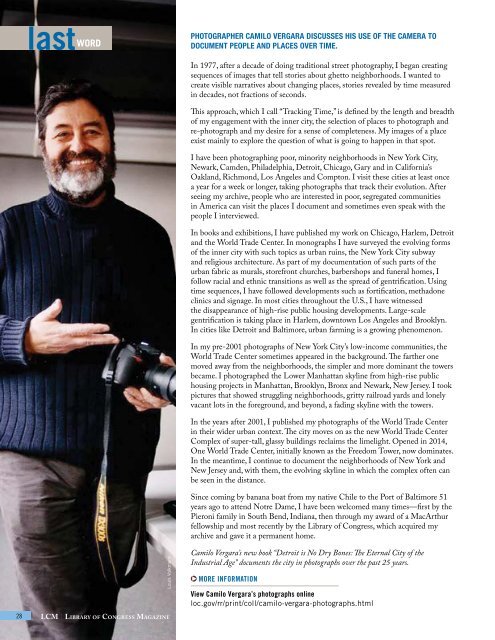THE POWER OF PHOTOGRAPHY
LCM_2016_1112
LCM_2016_1112
You also want an ePaper? Increase the reach of your titles
YUMPU automatically turns print PDFs into web optimized ePapers that Google loves.
last WORD<br />
PHOTOGRAPHER CAMILO VERGARA DISCUSSES HIS USE <strong>OF</strong> <strong>THE</strong> CAMERA TO<br />
DOCUMENT PEOPLE AND PLACES OVER TIME.<br />
In 1977, after a decade of doing traditional street photography, I began creating<br />
sequences of images that tell stories about ghetto neighborhoods. I wanted to<br />
create visible narratives about changing places, stories revealed by time measured<br />
in decades, not fractions of seconds.<br />
This approach, which I call “Tracking Time,” is defined by the length and breadth<br />
of my engagement with the inner city, the selection of places to photograph and<br />
re-photograph and my desire for a sense of completeness. My images of a place<br />
exist mainly to explore the question of what is going to happen in that spot.<br />
I have been photographing poor, minority neighborhoods in New York City,<br />
Newark, Camden, Philadelphia, Detroit, Chicago, Gary and in California’s<br />
Oakland, Richmond, Los Angeles and Compton. I visit these cities at least once<br />
a year for a week or longer, taking photographs that track their evolution. After<br />
seeing my archive, people who are interested in poor, segregated communities<br />
in America can visit the places I document and sometimes even speak with the<br />
people I interviewed.<br />
In books and exhibitions, I have published my work on Chicago, Harlem, Detroit<br />
and the World Trade Center. In monographs I have surveyed the evolving forms<br />
of the inner city with such topics as urban ruins, the New York City subway<br />
and religious architecture. As part of my documentation of such parts of the<br />
urban fabric as murals, storefront churches, barbershops and funeral homes, I<br />
follow racial and ethnic transitions as well as the spread of gentrification. Using<br />
time sequences, I have followed developments such as fortification, methadone<br />
clinics and signage. In most cities throughout the U.S., I have witnessed<br />
the disappearance of high-rise public housing developments. Large-scale<br />
gentrification is taking place in Harlem, downtown Los Angeles and Brooklyn.<br />
In cities like Detroit and Baltimore, urban farming is a growing phenomenon.<br />
In my pre-2001 photographs of New York City’s low-income communities, the<br />
World Trade Center sometimes appeared in the background. The farther one<br />
moved away from the neighborhoods, the simpler and more dominant the towers<br />
became. I photographed the Lower Manhattan skyline from high-rise public<br />
housing projects in Manhattan, Brooklyn, Bronx and Newark, New Jersey. I took<br />
pictures that showed struggling neighborhoods, gritty railroad yards and lonely<br />
vacant lots in the foreground, and beyond, a fading skyline with the towers.<br />
In the years after 2001, I published my photographs of the World Trade Center<br />
in their wider urban context. The city moves on as the new World Trade Center<br />
Complex of super-tall, glassy buildings reclaims the limelight. Opened in 2014,<br />
One World Trade Center, initially known as the Freedom Tower, now dominates.<br />
In the meantime, I continue to document the neighborhoods of New York and<br />
New Jersey and, with them, the evolving skyline in which the complex often can<br />
be seen in the distance.<br />
Since coming by banana boat from my native Chile to the Port of Baltimore 51<br />
years ago to attend Notre Dame, I have been welcomed many times—first by the<br />
Pieroni family in South Bend, Indiana, then through my award of a MacArthur<br />
fellowship and most recently by the Library of Congress, which acquired my<br />
archive and gave it a permanent home.<br />
28<br />
LCM | Library of Congress Magazine<br />
Louis Volkmann<br />
Camilo Vergara’s new book “Detroit is No Dry Bones: The Eternal City of the<br />
Industrial Age” documents the city in photographs over the past 25 years.<br />
MORE INFORMATION<br />
View Camilo Vergara’s photographs online<br />
loc.gov/rr/print/coll/camilo-vergara-photographs.html<br />
This view of lower Manhattan in 1970 shows the World Trade<br />
Center under construction. Camilo J. Vergara Collection, Prints and<br />
Photographs Division

















